Question 1. Will this saddle fit my donkey (horse or mule)?
Answer: Not every saddle will fit every donkey, horse, or mule, and finding the one that does fit requires knowing about saddle shapes, how saddles are made, and the seat and rigging pitch of their intended purpose (riding discipline). You also need to know about how your donkey (horse or mule) is put together and how he moves, and you need to be aware of how your "frame", which is your posture and balance affects how the saddle "seats" on his back and affects his ability to efficiently propel his body, and affects his ability to support your weight and affects his ability to STOP HIS MOTION WITHOUT HURTING HIMSELF. Betcha didn't even think of that, did you? That is something most riders do not even consider, but if their frame is pushing him forward, he can not stop without a jarring impact that risks injuring his back and legs. More about your frame later when we discuss riding in harmony or riding in discord with your mount.
Okay, wow, boy, that seems like a lot of technical stuff to learn before you can pick out a saddle for your donkey, but hey, how much time and attention do you devote to picking out a pair of shoes for yourself? You know your own feet. You know their shape and you know how your posture and stride makes wear patterns on your shoes. Do you run over your heels? Do you need arch supports? Do you slap your feet down? Do you stub your toe and stumble often? If you haphazardly pick out a pair of shoes and they do not "fit" your feet, ouch, you going to pay dearly with blisters and sores for squeezing your tender tootsies in a shoe that does not fit, or if the shoe is not suitable for your purpose. It is just plain common sense you would not wear heavy steel-toed leather lace-up hightop work boots to run a marathon. The steel-toed leather lace-ups are designed to protect your feet, but they are not designed for running. So, the first thing we should discuss is how the design of a structure suits its purpose.
Question 2. What is a saddle? What is its purpose?
Answer: The only purpose of a saddle is to distribute a rider's weight over the animal's back to avoid bridging, poking, gouging, and pressure points. That's it. A saddle has no other purpose. No matter what kind of saddle it is, or how much it cost, or what namebrand it is, the purpose of the saddle remains the same. It is to protect the back of the animal from the rider's weight.
Question 3. Doesn't a saddle provide security for the rider?
Answer: No. If a rider loses his balance and his rhythm becomes in discord with the animal, a saddle is not going to prevent him from bouncing higher and higher until he is launched in an unexpected dismount to eat dirt. When a rider expects a saddle to "help" him ride, it is an accident waiting to happen because no saddle, any saddle, it does not matter what kind it is, has magical velcro powers to keep a rider's rump centered in the seat.
Question 4. Can't a rider hold on to the horn to help him stay in the saddle?
Answer: He can hold on to the horn if he wants to, but choking the horn with one or both hands is not going to keep him in the saddle's seat if he is out of cadence with the animal. Grabbing "leather" might even hasten his launch since his upper torso would be out of alignment with his hips and as he stiffens his upper body his legs become unstable moving before or behind the point of motion and his reaction will likely be he will hunch over the horn shifting his entire body weight forward and that position puts his face in the danger zone for getting thwacked in the nose if the animal throws it's head up objecting to the increased weight on its forehand. Every movement of the rider's body triggers a shift in the amount and location of distribution of the weight bearing on the tree and that causes the mount to counter the movement. Grabbing the horn can begin a domino effect of actions that can end up very unpleasantly for a rider.
Question 5. If grabbing the horn is not a good idea, why do pleasure saddles even have horns?
Answer: Not all saddles used for pleasure riding have horns, some do and some don't. The stock type saddles used for pleasure that do have horns, the horns are a decoration and they are a handy place to attach a pommel bag of snacks.
Question 6. What is a pleasure saddle?
Answer: Unfortunately there is no specific category that "this" saddle is a pleasure saddle. There are stock saddles, roping saddles, penning saddles, cutting saddles, lightweight saddles, ranch saddles, Walking Horse saddles, trail saddles, synthetic saddles, leather saddles, barrel racing saddles, equitation saddles, flex-tree saddles, mule saddles, plain saddles, tooled saddles, silver-laced saddles, Arabian saddles, square skirts, round skirts, double-rigging, 7/8 rigging, 3/4 rigging, in-skirt rigging, dropped rigging, forward rigging, 14 inch seat, 15 inch seat, 16 inch seat, 17 inch seat, 18 inch seat, 19 inch seat, 22 inch seats for those of ample rumpness, all-purpose saddles, hunt seat saddles, dressage saddles, saddle-seat saddles, Australian saddles, endurance saddles, and I should mention bareback saddles,Tree-Less saddles and Natural-Ride saddles which aren't even saddles at all. That is a lot of saddle styles, sizes, and rigging to choose from when you are looking for a pleasure saddle to fit your donkey.
Question 7. All I want is a saddle so I can ride my donkey without hurting his back, why does it have to be so complicated?
Answer: It is not complicated if you evaluate saddles by their structure and not by how fancy or "pretty" they look. What you see on the outside, the color of the leather, tooled or not tooled, fancy stitching or lacing, or no fancy stitching and lacing, even the seat color has nothing to do with how suitable that saddle is for your donkey. Under all of that leather, tooling, stitching, lacing, synthetic fabric, padded or not padded seat is the Heart of the saddle, and that is the tree.
It is the shape and size of the tree that determines how the saddle will fit and distribute the rider's weight for the most comfort of the animal and not interfere with his ability to move.
There are english trees, western trees, modified trees, and hybrid trees, but for this discussion we are going to focus on the western or stock type trees. Western type trees are made of hardwood or wood composites and are covered with either bullhide, rawhide, fiberglass, or resin.
If the gullet is too wide or is not high enough, the angle of bars are too steep or too flat, or the arc of the weight distributing tree-foot has too much curve the saddle will rock, gouge, slip, slide, and creep causing sore spots. Some horse saddles can be adapted to fit donkeys but finding a properly fitting saddle for your donkey depends on understanding there are differencess between the back and ribs of a horse and the back and ribs of a donkey and then finding a saddle that will "seat" on your donkey's back to distribute the rider's weight without bridging, gaps, or pinching.
The spine crown and rib spring of a horse are rounder and somewhat oval. The spine crown and rib spring of a donkey are pear-shape. The donkey is narrower at the top and widens through the belly, and is narrower at the Heart of the Girth and wider at the loin.
A horse has a high spine crown (colored yellow) to protect the shoulder blade. A donkey has a low spine crown at the shoulder blade and if a saddle is placed forward on top of the shoulder it will interfere with the motion of the donkey's shoulder blade.
But that is not the only difference in the shape of a horse's back and the shape of a donkey's back. There is a difference in the arc or curve of a horse's back and a donkey's back. A horse may have a 20 to 30 degree slope at the wither and a 5 to 10 degree slope at the loin (lumbar - colored red) being steeper at the wither and flatter at the loin. But a donkey may have a 5 to 10 degree slope at the wither and a 15 to 20 degree slope at the loin, being flatter at the wither and steeper at the loin. So a donkey is flatter and narrower at the wither and steeper and wider at the loin, the opposite of the most common shape of a horse's back. A saddle with a tree shaped to fit close on a horse's back will be too shallow for a donkey's higher spine crowns, it may rock on a donkey's back with the telltale "pop-up" at the rear and if it is cinched down snug it forces the arc of the tree into the donkey's back. Ouch. That would be like trying to ignore a sharp pebble in your shoe that was digging into the sole of your foot.
To evaluate a saddle you have to turn it over and use your fingertips to feel though the felt-lining or sheepskin lining to find the edges and angles of the tree bars. You want to determine 1) the bar length, 2) the bar spread front and rear, 3) the bar angles, and 4) the gullet width and height and compare them to the shape and size of your donkey's back.
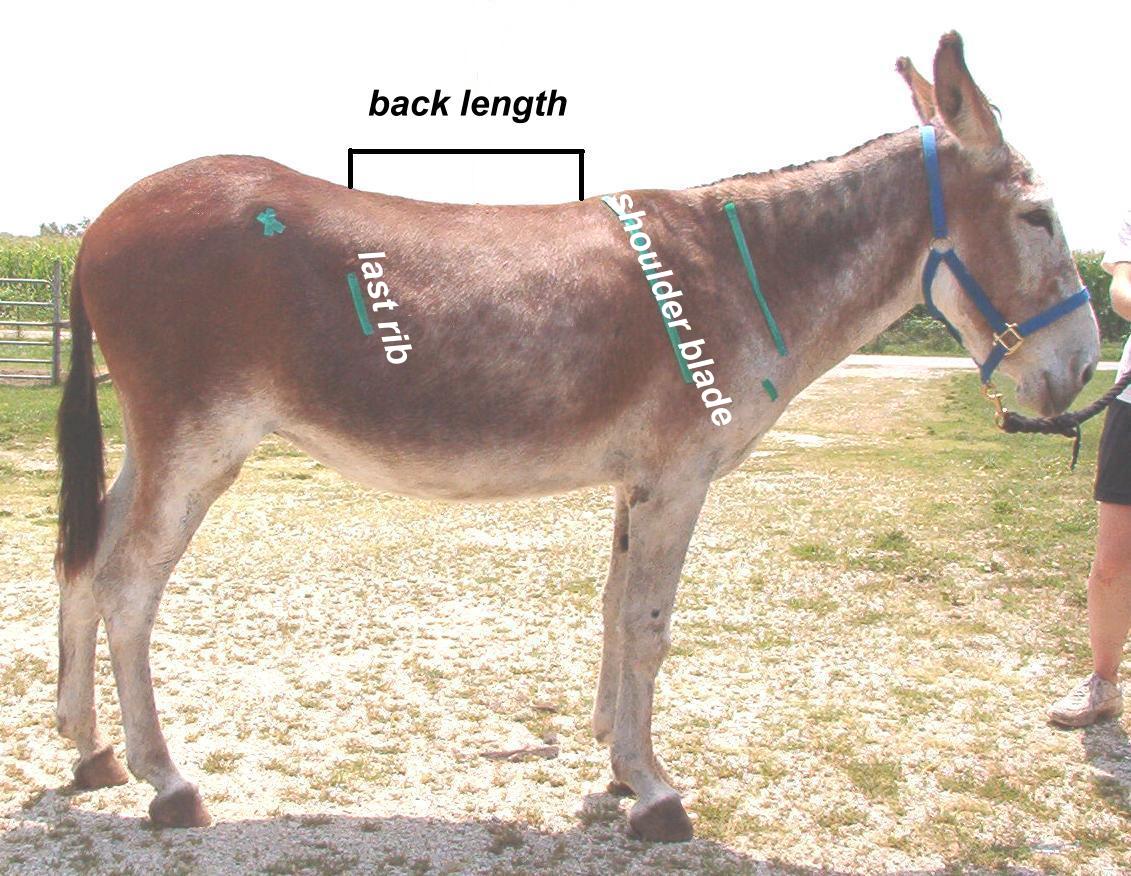

This is a 51 inch jennet with the typical back shape for a donkey. You can compare her back shape to the other two donkeys in the photo on the right.
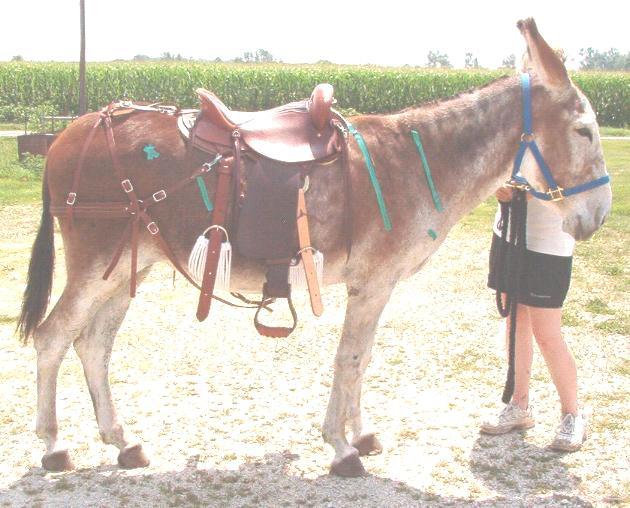
This is the same jennet wearing a 16 inch seat American Saddlery leather endurance saddle No. 805 without a saddle blanket so you can see the proper placement of a saddle on a donkey and how the fiberglass-covered hardwood professional endurance tree of the ASE "seats" on her back.
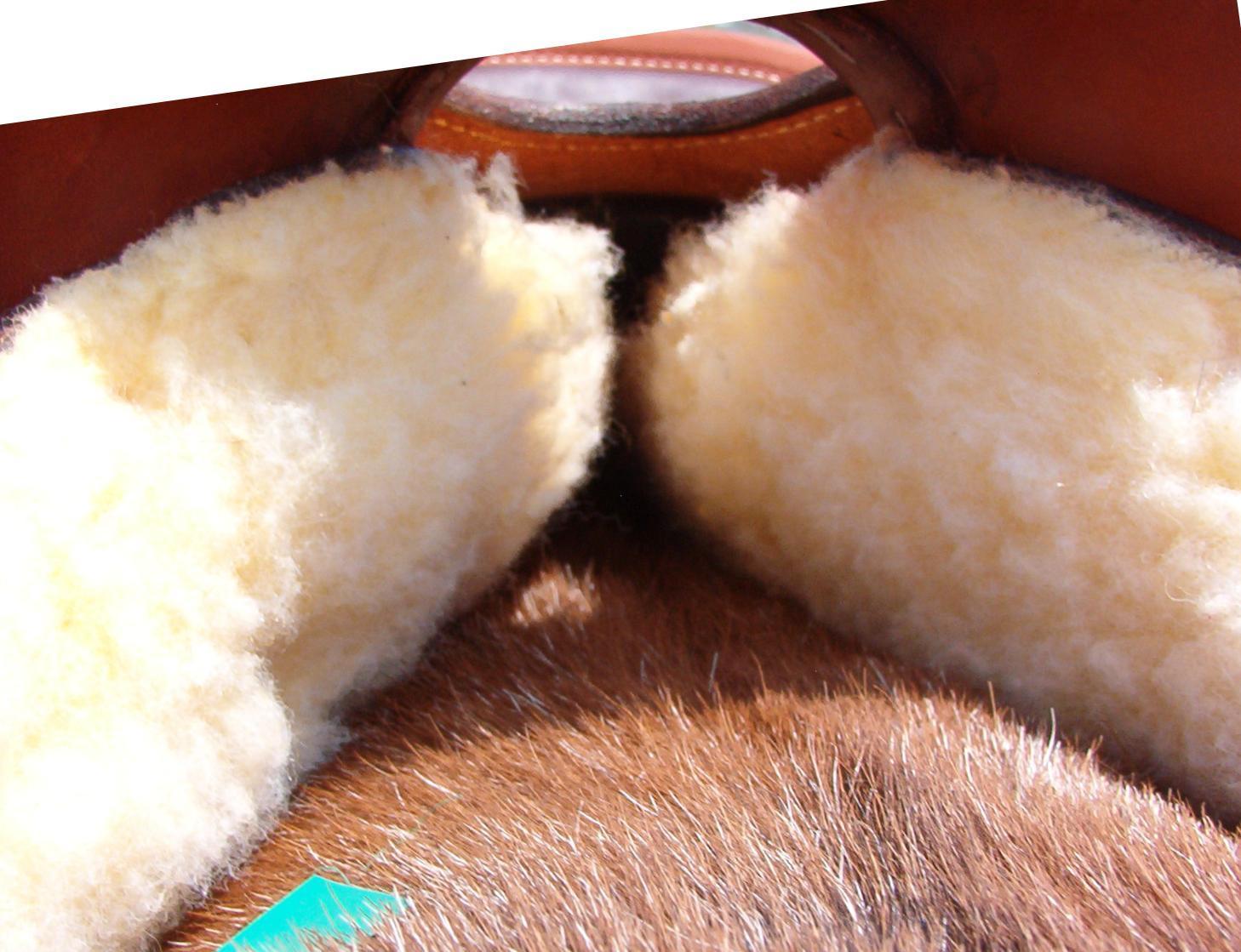
This is a view of the gullet so you can see how the bars follow the jennet's back shape. I have found the ASE saddle fits most donkeys 50 inches and taller and the American Saddlery cordura endurance saddles with the Amtech trees also fit the back shape of donkeys.
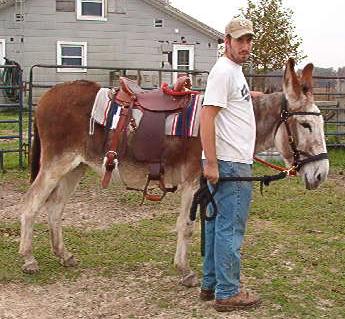
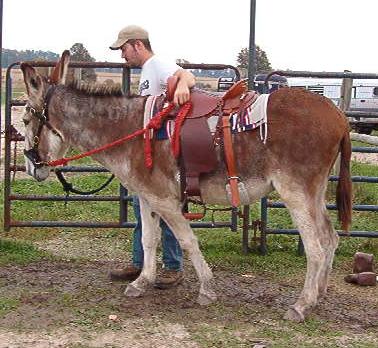
Another saddle that fits the back shape of donkeys is the 15 3/4 inch seat Rough-Out Saddle built on a regular tree with a 5 3/4 inch gullet.

Rigging for a donkey is full double rigging with the use of strand girths front and rear and the use of slant holdback straps from the rear saddle dee to the front girth dee. Strand girths remain in place even with a donkey's dense coat on their underside where web, neoprene, and fleece girths sit on top of the fuzzy coat and slip and slide. A properly fitting saddle placed in the correct position on the donkey's back (not on the donkey's shoulder blades) will stay put without creeping, crawling, slipping, and sliding while riding on the flat or climbing hills without the use of a breast collar, breeching, or crupper that can restrict the donkey's ability to use his body in the safest and most efficient way to carry a rider if the rider rides in harmoney with the donkey.
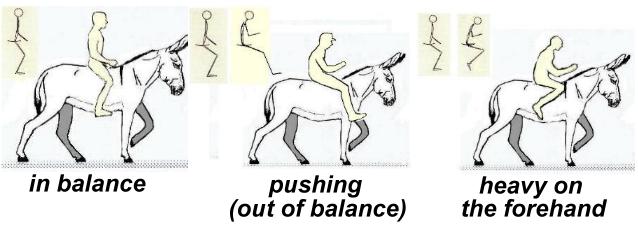
The rider's "frame" should be the posture of standing, not sitting. You sit on a chair because a chair is not in motion. The standing posture allows your body to adjust to the movement and stay in rhythm with the motion of the animal. Your shoulders are in alignment with your hips, and your hips swivel to match the movement of the donkey's rear legs (think of the John Wayne walk).When you ride you are not just a passive passenger sitting on a moving animal. Your body merges with his body so your are moving in unison.
I will add more information and pictures as time allows.